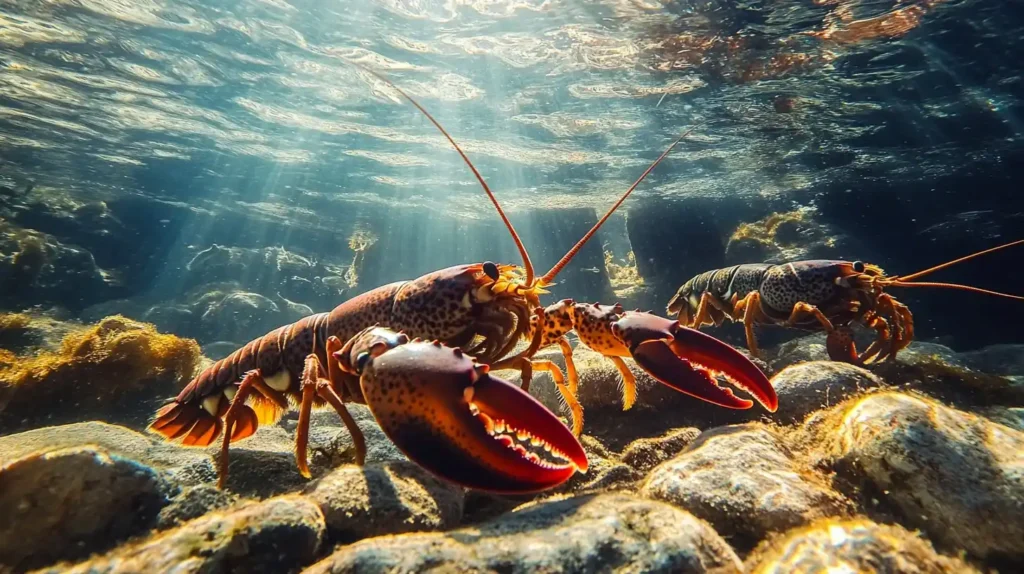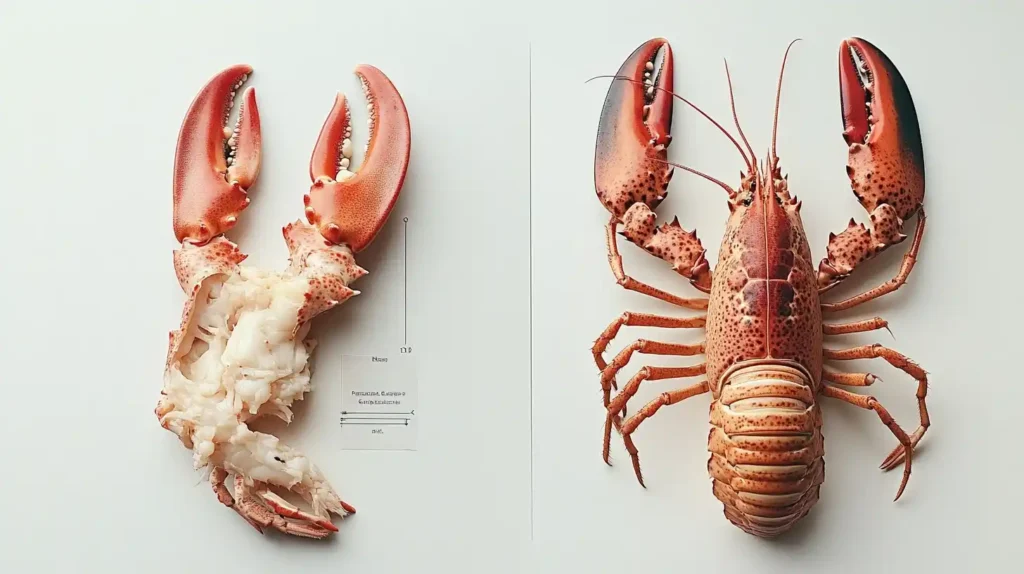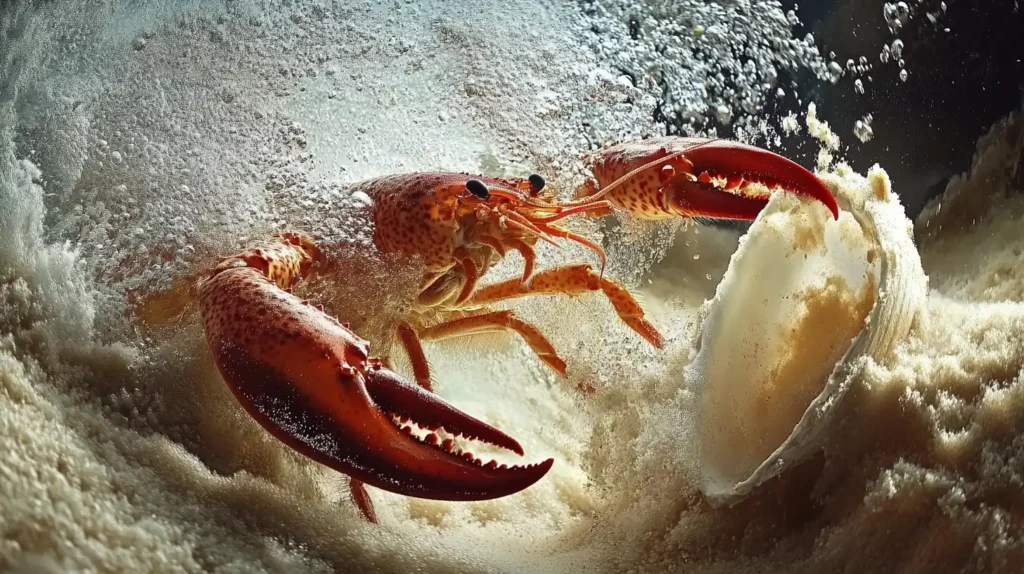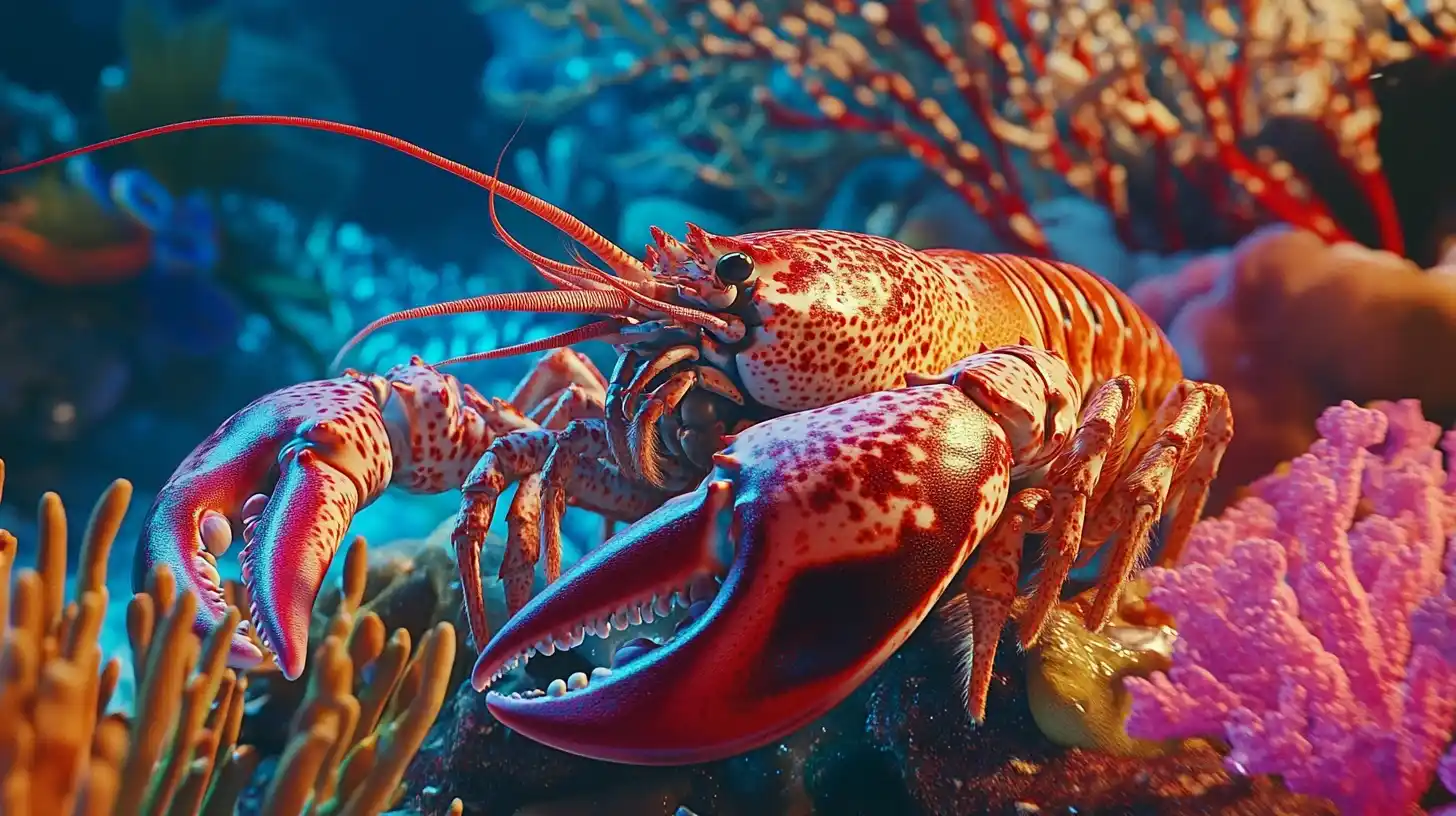Lobsters are fascinating sea creatures known for their distinctive claws. These appendages are not just for show—they play a vital role in the lobster’s life. So, what are lobster claws called? The larger claw is known as the crusher claw, while the smaller one is called the pincer claw or cutter claw. These names reflect the distinct roles each claw plays in eating, defense, and even lobster social interactions.
Understanding lobster claws helps us appreciate how these creatures survive and thrive in their environments. If you’re curious about lobster anatomy, check out this comprehensive guide on lobster anatomy for more details.
Table of contents

The Anatomy of Lobster Claws
Lobster claws, known scientifically as chelipeds, are unique tools that distinguish these crustaceans from other sea creatures. Each claw has a specific role in a lobster’s life, from catching prey to defending itself. Let’s explore the unique features of each claw and how they function.
1. The Crusher Claw
The crusher claw is the larger of the two claws. It’s built for strength and is designed to crush and break the shells of prey. This claw is like a lobster’s hammer, allowing it to crack through hard surfaces with ease.
- Structure: The crusher claw is wide and rounded, making it ideal for delivering powerful blows.
- Purpose: It’s primarily used to break apart tough prey like crabs and clams.
- Strength: Packed with strong muscles, it’s one of the lobster’s main survival tools.
2. The Pincer Claw
The pincer claw is smaller and sharper than the crusher claw. It works more like scissors, cutting and tearing food into smaller, manageable pieces.
- Structure: The pincer claw has a narrow, pointed shape.
- Purpose: It’s excellent for precision tasks, such as slicing soft prey or holding objects.
- Agility: This claw is faster and more flexible, making it perfect for delicate movements.
Differences Between the Two Claws
While both claws are vital, their differences in size, shape, and strength make them highly specialized. Together, they help the lobster adapt to various challenges in its underwater world.
If you want to learn about how these claws support survival, check out this ethical lobster fishing
How Lobsters Use Their Claws
Lobster claws are versatile tools that help these creatures survive in the wild. They are essential for catching prey, defending against threats, and interacting with other lobsters. By using their crusher and pincer claws strategically, lobsters adapt to various challenges in their underwater environment.
1. Catching and Preparing Food
Lobsters depend on their claws to find and eat a wide range of prey.
- The crusher claw smashes the hard shells of prey like crabs and mussels, making the food easier to access.
- Meanwhile, the pincer claw cuts and tears softer prey into manageable pieces, ensuring the lobster can consume it efficiently.
Together, these claws work like a hammer and scissors, enabling the lobster to eat different types of prey. This adaptability ensures they remain well-fed, even in competitive habitats.

2. Fighting and Defense
When faced with danger, lobsters actively use their claws to protect themselves.
- The crusher claw delivers strong, crushing blows to deter predators or rival lobsters.
- At the same time, the pincer claw can grab and injure attackers with its sharp edges.
These claws are also essential during territorial disputes. For instance, when two lobsters compete over shelter or resources, their claws help establish dominance. By winning such battles, lobsters secure better living conditions, which improves their chances of survival.
3. Mating and Social Interactions
Claws are not only useful for survival they also play a crucial role in social behavior and mating.
- Male lobsters, for example, often rely on their claws to demonstrate strength during mating rituals. A larger crusher claw signals fitness, which increases the chances of attracting a female.
- Additionally, during courtship, males may use their claws to fend off other competitors, securing their opportunity to mate.
These interactions highlight how claws serve as more than functional tools they are also symbols of strength and dominance in the lobster community.
By actively using their claws for such a wide variety of tasks, lobsters demonstrate remarkable adaptability. Their ability to combine strength and precision makes these appendages indispensable for survival.
Claw Growth and Regeneration
Lobsters have a fascinating ability to regrow their claws, which is essential for their survival. This process, known as regeneration, ensures that lobsters can recover from injuries or losses caused by predators or fights. Let’s explore how lobsters grow their claws and why this ability is so important.
How Do Lobsters Regrow Their Claws?
When a lobster loses a claw, it doesn’t mean the end of its survival. In fact, the lobster actively regenerates the claw through a process linked to molting.
- Molting and Claw Growth: Lobsters shed their hard exoskeletons during molting, which allows their body to grow. During this process, a new claw begins to form.
- Gradual Regeneration: The new claw starts small but becomes larger with each molting cycle. Over time, the regenerated claw can match the original in size and strength.
- Functionality: Even though the new claw is smaller at first, it is still functional and helps the lobster adapt quickly to its environment.
This ability gives lobsters a significant advantage, as they can replace their primary tools for eating and defense.
Why Is Regeneration Important?
Lobsters face many dangers in the wild, and their claws are often the first line of defense. Losing a claw can happen during:
- Fights with other lobsters over food or territory
- Escaping from predators that grab onto a claw
- Accidents during handling or fishing
Without claws, lobsters would struggle to survive. However, thanks to regeneration, they can regain their strength and continue thriving.
How Long Does Regeneration Take?
The time it takes for a lobster to fully regrow a claw depends on its size and the number of molting cycles it undergoes.
- Smaller lobsters molt more frequently, so they can regrow claws faster.
- Larger lobsters molt less often, which means regeneration takes longer.
On average, it may take several months to a few years for a claw to fully regenerate. While this might seem like a slow process, it’s a vital adaptation for survival in harsh underwater environments.
By being able to regrow their claws, lobsters showcase their resilience and adaptability. This natural ability not only keeps them safe but also ensures they can continue to find food and defend themselves effectively.
Culinary Value of Lobster Claws
Lobster claws are a delicacy, offering a unique combination of texture and flavor.
- Crusher Claw Meat: Firm and slightly fibrous, it’s perfect for hearty dishes.
- Pincer Claw Meat: Softer and sweeter, it works well in soups and salads.
If you enjoy exploring new recipes, consider pairing lobster claws with ideas from The Ultimate Guide to Making the Perfect Cottage Cheese Bake for a creative culinary twist.

Why Are Lobster Claws So Popular?
Lobster claws are sought after for their unique texture and taste.
- The crusher claw offers meat that is firm and slightly fibrous, making it ideal for hearty dishes.
- On the other hand, the pincer claw has softer, sweeter meat that works well in delicate recipes.
This variety in texture and flavor ensures that lobster claws suit different types of dishes, from rich soups to fresh salads. Furthermore, claw meat is easy to extract compared to other parts of the lobster, which adds to its popularity.
Health Benefits of Lobster Claws
In addition to their delicious taste, lobster claws are a healthy choice for many people.
- Rich in Protein: Claw meat is high in protein, which helps build muscle and repair tissues.
- Low in Fat: Lobster claws have very little fat, making them a lean option for those watching their diet.
- Packed with Nutrients: They are a great source of essential nutrients like zinc, selenium, and vitamin B12, which support overall health.
With these benefits, it’s no surprise that lobster claws are a favorite for both flavor and nutrition.
Popular Ways to Cook Lobster Claws
Lobster claws are versatile and can be prepared in many ways to suit different tastes. Some popular cooking methods include:
- Grilling: Grilled lobster claws develop a smoky flavor that enhances their natural sweetness.
- Steaming: This simple method preserves the delicate texture and taste of claw meat.
- Making Bisque: Lobster claw bisque is a creamy soup that highlights the richness of the meat.
- Adding to Salads: Claw meat adds a burst of flavor and protein to fresh vegetable or pasta salads.
For expert tips on cooking lobster claws, check out this helpful cooking guide.
Ethical and Sustainable Choices
When enjoying lobster claws, it’s important to consider sustainability. Choosing lobsters from ethical fishing practices ensures that these creatures can continue to thrive in their habitats. Always look for suppliers that follow environmentally friendly methods to protect the lobster population.
Lobster claws are a perfect mix of flavor, nutrition, and versatility. Whether grilled, steamed, or added to soups, they bring a unique taste to any dish.
FAQs About Lobster Claws
Lobster claws are fascinating and often raise questions among seafood lovers. From their biology to their culinary uses, there’s plenty to learn about these unique appendages. Here are some of the most common questions people ask about lobster claws.
1. Can Lobsters Regrow Their Claws?
Yes, lobsters can regrow their claws if they lose one.
- This process is called regeneration.
- New claws start small but grow larger with each molting cycle.
- Eventually, the regenerated claw becomes as strong and functional as the original.
This ability is crucial for a lobster’s survival in the wild, helping them recover from injuries and continue thriving.
2. What Happens When a Lobster Loses Both Claws?
Losing both claws is rare but not fatal for lobsters.
- A clawless lobster can still feed by using its legs to manipulate food.
- Although more vulnerable to predators, it can survive until the claws regenerate.
This resilience shows how adaptable lobsters are, even in challenging situations.
3. Why Are Male and Female Lobster Claws Different?
Male and female lobsters often have differences in claw size and shape.
- Males usually have larger claws, which they use in battles for dominance and territory.
- Female lobsters prioritize reproduction, so their claws are often smaller and less robust.
These differences reflect the unique roles each gender plays in the lobster’s lifecycle.
4. Is All Lobster Claw Meat Edible?
Yes, all claw meat is edible, but some parts are better left out.
- The soft, flavorful meat inside the claw is the most desirable.
- However, the cartilage inside the claw should be removed before eating.
By properly preparing the claws, you can enjoy every bite of this delicious seafood.
5. How Long Does It Take for a Lobster Claw to Regrow?
The time it takes for a lobster to regrow a claw depends on its size and molting frequency.
- Smaller lobsters molt more often, so they regrow claws faster.
- Larger lobsters molt less frequently, making the process slower.
On average, it can take several months to a few years for a lobster to fully regenerate its claw.
6. What’s the Difference Between Claws and Legs?
Lobster claws are specialized for specific tasks like crushing and cutting, while their legs are used mainly for walking and fine manipulation.
- Claws are much stronger and more muscular.
- Legs, in contrast, are slender and more flexible, allowing lobsters to perform delicate tasks.
7. Are Lobster Claws Stronger with Age?
Yes, older lobsters tend to have stronger claws.
- As lobsters age, their claws grow larger and develop more powerful muscles.
- This makes them better equipped to handle prey and defend themselves.
Lobster claws are not just fascinating they’re full of surprises. Their ability to regrow, their differences between genders, and their culinary appeal make them a topic worth exploring.
Conclusion
Lobster claws, also known as the crusher claw and pincer claw, are more than fascinating appendages. They are critical tools for feeding, fighting, and surviving in the wild. Beyond their biological roles, these claws are celebrated for their exceptional flavor, making them a prized ingredient in many cuisines.
Whether you’re enjoying the sweet meat of a lobster claw or marveling at its strength, these claws represent the remarkable adaptability of lobsters. By supporting sustainable fishing practices, we can ensure these incredible creatures continue to thrive in our oceans for years to come.
Lobster claws are a testament to the ingenuity of nature, combining function, form, and flavor in one extraordinary package.

